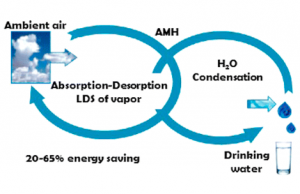Les scientifiques du Technion (Haïfa, Israël) ont mis au point un système innovant pour récolter de l’eau potable à partir de l’air. Capter l’humidité atmosphérique n’est pas une nouveauté en soi, des générateurs d’eau atmosphérique à usage commercial et domestique existent déjà. Mais ce nouveau dispositif nécessite moins d’énergie pour produire de l’eau de haute qualité comparé aux systèmes existants.
L’atmosphère contient de la vapeur d’eau dans des quantités comparables à celles se trouvant sur toute la surface de la Terre et dans les eaux souterraines sur la planète. Mais les équipements actuels sont très limités. Ils utilisent la réfrigération électrique pour refroidir l’air et condenser la vapeur ce qui consomme beaucoup d’énergie.
Le dessalement d’eau de mer par osmose inverse, très bien maîtrisé en Israël, est une autre source potentielle d’eau douce, mais il n’est pas disponible dans les pays qui ne disposent pas d’accès à la mer. En outre, le dessalement nécessite des investissements importants en tuyauteries et pompage, en termes d’infrastructures, de gestion et de maintenance. « Alors que l’humidité atmosphérique est accessible partout», souligne l’étude.
Le nouveau système conçu par les scientifiques du Technion utilise un déshydratant liquide pour séparer d’abord la vapeur d’eau de l’air, et ensuite refroidir seulement la vapeur. Leurs calculs montrent que cette approche se traduirait par 20 à 65% d’économies d’énergie par rapport au système standard.
Publication dans Environmental Science & Technology, 20 juillet 2016
Traduction/adaptation Esther Amar pour Israël Science Info
Source texte en anglais indianexpress



















